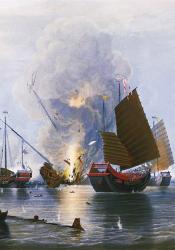Calcutta, India
The opium trade route between China, England, and India is known as the "opium triangle." The route began with India before moving to China. There, the opium was depositied and goods traded to England as payment. In 1750, Britain gained control of Bengal (Calcutta), India, a district well known for its opium growing. Bengali opium was valued over Chinese opium because of its fine quality. During the Victorian era, Britian experienced a large demand for Chinese products such as tea and porcelain. Wanting to maintain control over the trade market, the East India Trading Company used private traders to send opium from Bengal into China in order to create demand. Once the Chinese demanded more opium, Britain was able to control the market for tea, porcelain, and other items by trading opium rather than silver.
Because of their actions, Britain essentially created a country of opium addicts. This led to conflict between England and China as seen in the Opium Wars I have previously covered. For a visual explanatio of the opium triangle, click the link below.
Coordinates
Longitude: 87.854975500000


